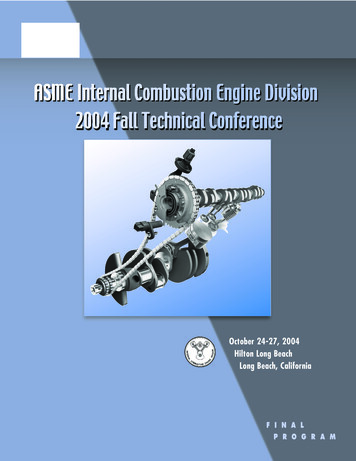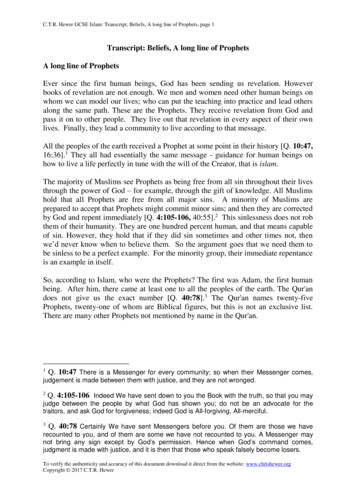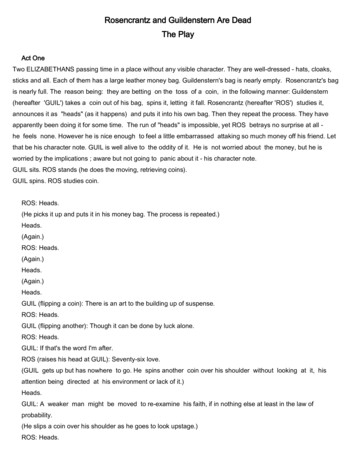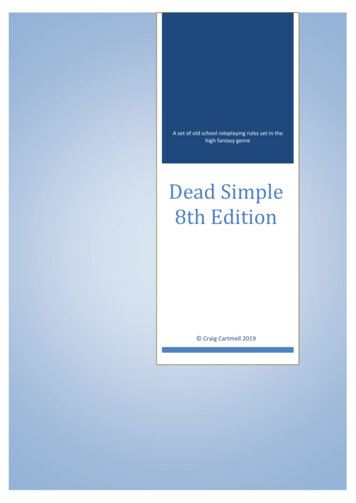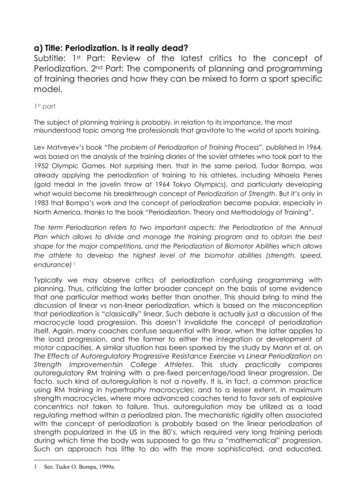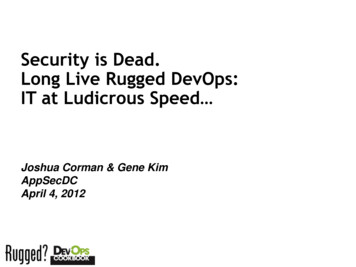
Transcription
Security is Dead.Long Live Rugged DevOps:IT at Ludicrous Speed Joshua Corman & Gene KimAppSecDCApril 4, 2012Session ID:
About Joshua Corman Director of Security Intelligence for Akamai Technologies Former Research Director, Enterprise Security [The 451 Group] Former Principal Security Strategist [IBM ISS] Industry: Expert Faculty: The Institute for Applied Network Security (IANS)2009 NetworkWorld Top 10 Tech People to KnowCo-Founder of “Rugged Software” www.ruggedsoftware.orgBLOG: www.cognitivedissidents.com Things I’ve been researching: 2Compliance vs SecurityDisruptive Security for Disruptive InnovationsChaotic ActorsEspionageSecurity Metrics
About Gene Kim Researcher, Author Industry: Invented and founded Tripwire, CTO (1997-2010) Co-author: “Visible Ops Handbook”(2006), “Visible Ops Security” (2008) Co-author: “When IT Fails: The Novel,” “The DevOps Cookbook” (ComingMay 2012) Things I’ve been researching: Benchmarked 1300 IT organizations to test effectiveness of IT controls vs.IT performance DevOps, Rugged DevOps Scoping PCI Cardholder Data Environment3
Consequences: Value & 2011/10/24/a-replaceability-continuum/4
Dogma: You Don’t Need To Be FasterThan the Bear 5
How will we -comments
Vanity Fair: World War 3.0The battle for the Net b/w Chaos & nternet-regulation-war-sopa-pipa-defcon-hacking
The Downward SpiralOperations Sees Fragile applications are prone tofailure Long time required to figure out “whichbit got flipped” Detective control is a salesperson Too much time required to restoreservice Too much firefighting and unplannedwork Urgent security rework andremediation Planned project work cannot complete Frustrated customers leave Market share goes down Business misses Wall Streetcommitments Business makes even larger promisesto Wall StreetDev Sees More urgent, date-driven projectsput into the queue Even more fragile code (lesssecure) put into production More releases have increasingly“turbulent installs” Release cycles lengthen toamortize “cost of deployments” Failing bigger deployments moredifficult to diagnose Most senior and constrained ITops resources have less time tofix underlying process problems Ever increasing backlog of workthat cold help the business win Ever increasing amount oftension between IT Ops,Development, Design These aren’t IT or Infosec problems These are business problems!
Good News: It Can Be DoneBad News: You Can’t Do It Alone
Ops
QA And TestSource: Flickr: vandyll
Development
Infosec
Product Management And DesignSource: Flickr: birdsandanchors
Agenda Problem statement What is DevOps? What is Rugged? What is Rugged DevOps? Things you can do right away16
Potentially Unfamiliar Words You Will See Kanban Andon cord Sprints Rugged DevOps Bottleneck Systems thinking Controls reliance17
Problem Statement18
Ludicrous Speed?19
Ludicrous Speed20
Ludicrous Speed!21
Ludicrous Fail?!22
What Is DevOps?23
Source: John Allspaw
Source: John Allspaw
Source: John Allspaw
Source: John Allspaw
Source: Theo Schlossnagle
Source: Theo Schlossnagle
Source: Theo Schlossnagle
Source: John Jenkins, Amazon.com
What Is Rugged?35
Rugged Software DevelopmentJoshua Corman, David Rice, Jeff Williams2010
RUGGED SOFTWARE
so software not only needs to be
FAST
AGILE
Are You Rugged?
HARSH
UNFRIENDLY
THE MANIFESTO
I recognize that my code will be used in ways Icannot anticipate, in ways it was not designed,and for longer than it was ever intended.
konline.org/issues/marchapril-2011.html
What Is Rugged DevOps?51
Source: James Wickett
Source: James Wickett
Survival Guide/Pyramidwww.ruggedsoftware.orgDefensible Infrastructure
Survival Guide/PyramidOperational DisciplineDefensible Infrastructure
Survival Guide/PyramidSituational AwarenessOperational DisciplineDefensible Infrastructure
Survival Guide/PyramidCountermeasuresSituational AwarenessOperational DisciplineDefensible Infrastructure
Zombie Proof sSituational AwarenessOperational DisciplineDefensible Infrastructure
Zombie Proof sSituational AwarenessOperational DisciplineDefensible Infrastructure
Zombie Proof sSituational AwarenessOperational DisciplineDefensible Infrastructure
Zombie Proof sSituational AwarenessOperational DisciplineDefensible Infrastructure
Zombie Proof sSituational AwarenessOperational DisciplineDefensible Infrastructure
Zombie Proof sSituational AwarenessOperational DisciplineDefensible Infrastructure
Zombie Proof sSituational AwarenessOperational DisciplineDefensible Infrastructure
Source: James Wickett
How Do You DoRugged DevOps?69
The Prescriptive DevOps Cookbook “DevOps Cookbook” Authors Patrick DeBois, Mike Orzen,John Willis Goals Codify how to start and finishDevOps transformations How does Development, ITOperations and Infosecbecome dependable partners Describe in detail how toreplicate the transformationsdescribe in “When IT Fails: TheNovel”
The First Way:Systems Thinking
The First Way:Systems Thinking (Left To Right) Never pass defects to downstream work centers Never allow local optimization to create globaldegradation Increase flow: elevate bottlenecks, reduce WIP,throttle release of work, reduce batch sizes
Definition: Agile Sprints The basic unit of development in Agile Scrums,typically between one week and one month At the end of each sprint, team should havepotentially deliverable productAha Moment: shipping product implies not just code –73it’s the environment,too!
Help Dev And Ops Build Code AndEnvironments Dev and Ops work together in Sprint 0 and 1 tocreate code and environments Create environment that Dev deploys into Create downstream environments: QA, Staging,Production Create testable migration procedures from Dev all theway to production Integrate Infosec and QA into daily sprintactivities
The First Way:Systems Thinking: Infosec Get a seat at the table DevOps programs are typically led by Dev, QA, ITOperations and Product Management Add value at every step in the flow of work See the end-to-end value flow Shorten and amplify feedback loops Help break silos (e.g., server, networking, database)
The First Way:Systems Thinking: Infosec Insurgency Have infosec attend the daily Agile standups Gain awareness of what the team is working on Find the automated infrastructure project team (e.g.,puppet, chef) Provide hardening guidance Integrate and extend their production configurationmonitoring Find where code packaging is performed Integrate security testing pre- and post-deployment Integrate into continuous integration and releaseprocess Add security test scripts to automated test library
The First Way:Outcomes Determinism in the release processContinuation of the Agile and CI/CR processesCreating single repository for code and environmentsPackaging responsibility moves to developmentConsistent Dev, QA, Int, and Staging environments, allproperly built before deployment begins Decrease cycle time Reduce deployment times from 6 hours to 45 minutes Refactor deployment process that had 1300 stepsspanning 4 weeks Faster release cadence
The Second Way:Amplify Feedback Loops
The Second Way:Amplify Feedback Loops (Right to Left) Protect the integrity of the entire system of work,versus completion of tasks Expose visual data so everyone can see howtheir decisions affect the entire system
Definition: Andon Cord80
Integrate Ops Into Dev Embed Ops person into Dev structure Describes non-functional requirements, use casesand stories from Ops Responsible for improving “quality at the source”(e.g., reducing technical debt, fix known problems,etc.) Has special responsibility for pulling the Andon cord
Integrate Dev Into Ops MobBrowser case study: “Waking up developersat 3am is a great feedback loop: defects getfixed very quickly” Goal is to get Dev closer to the customer Infosec can help determine when it’s too close (andwhen SOD is a requirement)
Keep Shrinking Batch Sizes Waterfall projects often have cycle time of oneyear Sprints have cycle time of 1 or 2 weeks When IT Operations work is sufficiently fast andcheap, we may decide to decouple deploymentsfrom sprint boundaries (e.g., Kanbans)
Definition: Kanban Board Signaling tool to reduce WIP and increase flow84
The Second Way:Amplify Feedback Loops: Infosec Insurgency Extend criteria of what changes/deploys cannot bemade without triggering full retest Create reusable Infosec use and abuse stories thatcan be added to every project “Handle peak traffic of 4MM users and constant 4-6Gb/sec Anonymous DDoS attacks” Integrate Infosec and IR into the Ops/Dev escalationprocesses (e.g., RACI) Pre-enable, shield / streamline successful audits Document separation of duty and compensating controls Don’t let them disrupt the work
The Second Way:Outcomes Andon cords that stop the production line Kanban to control work Project freeze to reduce work in process Eradicating “quick fixes” that circumvent the process Ops user stories are part of the Agile planningprocess Better build and deployment systems More stable environment Happier and more productive staff
The Third Way:Culture Of Continual Experimentation AndLearning
The Third Way:Culture Of Continual Experimentation AndLearning Foster a culture that rewards: Experimentation (taking risks) and learning fromfailure Repetition is the prerequisite to mastery Why? You need a culture that keeps pushing into the dangerzone And have the habits that enable you to survive in thedanger zone
Help IT Operations “The best way to avoid failure isto fail constantly” Harden the productionenvironment Have scheduled drills to “crashthe data center” Create your “chaos monkeys” tointroduce faults into the system(e.g., randomly kill processes,take out servers, etc.) Rehearse and improveresponding to unplanned work NetFlix: Hardened AWS service StackOverflowAmazon firedrills (Jesse Allspaw)The Monkey (Mac)
You Don’t Choose Chaos Monkey Chaos Monkey Chooses You
HDMoore’s LawHDMoore’s Law10090Success Rate (%)8070Adversary Classes60EspionageOrganized Crime50APT/APAChaotic or/Assessor30CasualQSA2010x123456789101112Defender /2011/11/01/intro-to-hdmoores-law/
Help Product Management Lesson: Allocate 20% of Dev cycles to paying downtechnical debt
The Third Way:Culture Of Continual Experimentation AndLearning: Infosec Add Infosec fixes to the Agile backlog Make technical debt visible Help prioritize work against features and other non-functional requirements Weaponize the Security Monkey Evil/Fuzzy/Chaotic Monkey Eridicate SQLi and XSS defects in our lifetime Let loose the Security Monkies and the Simian Army Eliminate needless complexity Become the standard bearer: 20% of Dev cycles spent onnon-functional requirements Take work out of the system Keep decreasing cycle time: it increases work that the systemcan achieve
The Third Way:Outcomes 15 minutes/daily spent on improving daily work Continual reduction of unplanned work More cycles for planned work Projects completed to pay down technical debt andincrease flow Elimination of needless complexity More resilient code and environments Balancing nimbleness and practiced repetition Enabling wider range of risk/reward balance
The Upward Spiral95
What Does Rugged DevOpsFeel Like?96
Case Studies And Early Indicators Almost every major Internet online servicescompany VERACODE Rapid SaaS Fix Blog on Lithium response-done-right/ Pervasive Monitoring Analytics at LinkedIn viewed by CEO daily:LinkedIn Engineering: “The Birth Of inGraphs: EricThe Intern”
Applying RuggedDevOps101
Things To Put Into Practice Tomorrow Identify your Dev/Ops/QA/PM counterparts Discuss your mutual interdependence and sharedobjectives Harden and instrument the production builds Integrate automated security testing into the buildand deploy mechanisms Create your Evil/Hostile/Fuzzy Chaos Monkey Cover your untested branches Enforce the 20% allocation of Dev cycles to nonfunctional requirement
When IT Fails: The Novel and The DevOpsCookbook Coming in July 2012 “In the tradition of the best MBA case studies, thisbook should be mandatory reading for businessand IT graduates alike.” -Paul Muller, VPSoftware Marketing, Hewlett-PackardGene Kim, Tripwire founder,Visible Ops co-author “The greatest IT management book of ourgeneration.” –Branden Williams, CTOMarketing, RSA
When IT Fails: The Novel and The DevOpsCookbook Coming in July 2012 If you would like the “Top 10 Things YouNeed To Know About DevOps,” samplechapte
Co-author: “Visible Ops Handbook”(2006), “Visible Ops Security” (2008) Co-author: “When IT Fails: The Novel,” “The DevOps Cookbook” (Coming May 2012) Things I’ve been researching: Benchmarked 1300 IT organizations to test effectiveness of IT controls vs. IT performance DevOps, Rugged DevOps Scoping PCI Cardholder Data Environment 3 About Gene Kim . Consequences: Value .
